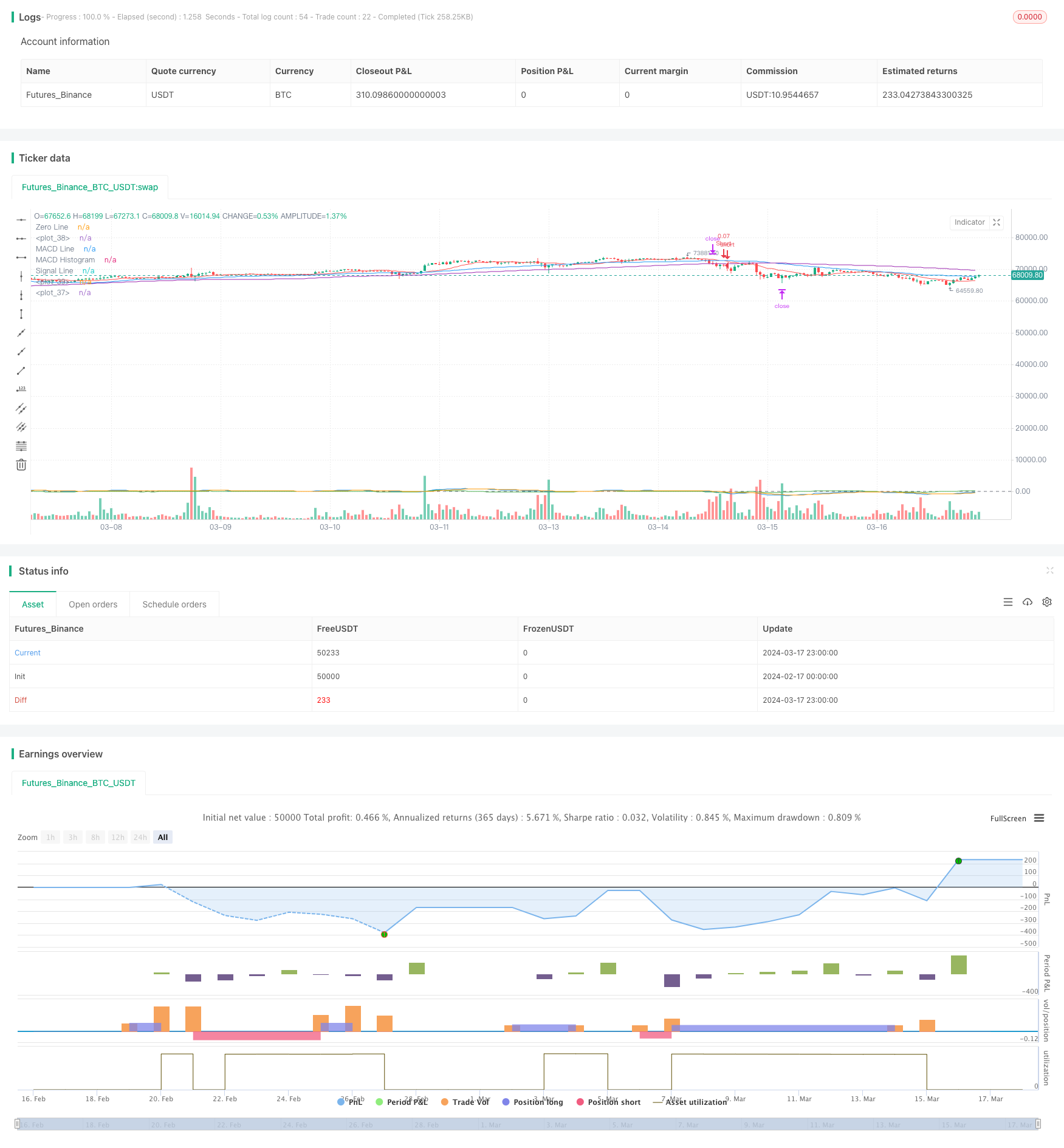
策略概述
该策略是一个结合了移动平均线(SMA)和移动平均线聚散指标(MACD)的XAUUSD交易策略。策略使用不同周期的SMA来判断趋势方向和潜在的进场点,并利用MACD指标来确认动量方向与SMA交叉产生的信号一致。此外,该策略还采用平均真实波幅(ATR)来设置动态止损和止盈水平,以适应不同的市场波动情况。
策略原理
该策略的核心原理可以分为三个部分:
趋势判断: 策略使用100周期的SMA来判断整体趋势方向。当价格在该SMA上方时,认为处于上升趋势,考虑做多;当价格在该SMA下方时,认为处于下降趋势,考虑做空。此外,策略还使用了15周期的快速SMA和45周期的慢速SMA,通过它们的交叉来识别更即时的趋势变化和潜在进场点。
动量确认: 策略采用MACD(12, 26, 9)指标来确认动量方向与SMA交叉产生的进场信号一致。当MACD线与信号线发生正背离(MACD线上穿信号线)时,支持做多;当MACD线与信号线发生负背离(MACD线下穿信号线)时,支持做空。
风险管理: 策略利用ATR(14周期)来设置动态止损和止盈水平,以适应当前市场波动情况。止损位置设置在距离进场价3倍ATR的位置,而止盈目标则设置在距离进场价6倍ATR的位置(是止损距离的两倍),以期望获得2:1的风险回报比。
该策略的多头进场条件为:收盘价在100周期趋势SMA上方,15周期快速SMA上穿45周期慢速SMA,MACD线在信号线上方(表明看涨动量)。空头进场条件为:收盘价在100周期趋势SMA下方,15周期快速SMA下穿45周期慢速SMA,MACD线在信号线下方(表明看跌动量)。
策略优势
趋势跟踪与动量相结合: 该策略利用不同周期的SMA来判断趋势方向,同时结合MACD指标来确认动量,能够在趋势明确且价格波动较大的市场中表现出色。
动态风险管理: 策略采用ATR来动态设置止损和止盈水平,能够根据当前市场波动情况自动调整风险管理,有助于提升策略在不同波动环境下的表现。
适用于系统化交易: 该策略的进场和出场条件都有明确定义,适合寻求系统化交易方法的交易者使用。
策略风险
震荡市: 当市场处于震荡区间时,该策略可能会产生较多的虚假信号,导致频繁交易和资金损失。
趋势反转: 当市场趋势发生突然反转时,该策略可能无法及时调整仓位,导致较大回撤。
参数优化: 该策略的表现依赖于SMA、MACD和ATR的参数选择,不同市场环境下最优参数可能有所不同,需要根据历史数据进行参数优化和调整。
优化方向
加入滤波条件: 可以考虑引入其他技术指标或价格行为特征作为附加条件,以过滤掉一部分虚假信号,提高信号质量。例如,可以结合布林带或者价格突破等方法。
改进风险管理: 除了基于ATR的动态止损和止盈,还可以探索其他风险管理方法,如基于波动率或者价格水平的止损,或者采用移动止损策略,以进一步控制风险敞口。
结合基本面分析: XAUUSD的价格走势受到多种基本面因素的影响,如货币政策、通胀预期、地缘政治风险等。将基本面分析纳入策略决策过程,有助于提高策略的适应性和稳健性。
总结
该策略是一个结合趋势跟踪和动量策略的XAUUSD交易方法,通过使用不同周期的SMA来判断趋势方向和潜在进场点,并利用MACD指标来确认动量方向与SMA信号一致。同时,该策略采用基于ATR的动态止损和止盈机制,能够根据市场波动情况自动调整风险管理。
该策略的优势在于趋势跟踪与动量相结合,以及动态的风险管理方式,适合在趋势明确且价格波动较大的市场中使用。但在震荡市或者趋势反转时,该策略可能面临较多虚假信号和回撤风险。
未来优化方向可以考虑引入附加的滤波条件、改进风险管理方法,以及结合基本面分析,以提高策略的信号质量、风险控制能力和适应性。在实际应用前,还需要根据历史数据进行参数优化和回测,并根据个人风险偏好进行必要调整。
/*backtest
start: 2024-02-17 00:00:00
end: 2024-03-18 00:00:00
period: 1h
basePeriod: 15m
exchanges: [{"eid":"Futures_Binance","currency":"BTC_USDT"}]
*/
// This Pine Script™ code is subject to the terms of the Mozilla Public License 2.0 at https://mozilla.org/MPL/2.0/
// © Egede
//@version=5
strategy("Refined XAUUSD SMA and MACD Strategy", overlay=true, default_qty_type=strategy.percent_of_equity, default_qty_value=10)
// Moving Averages for trend direction and entry signals
trendSMA = ta.sma(close, 100) // Trend direction SMA
fastSMA = ta.sma(close, 15)
slowSMA = ta.sma(close, 45)
// MACD parameters for entry signal strength
[macdLine, signalLine, _] = ta.macd(close, 12, 26, 9)
// ATR for dynamic stop loss and take profit
atrPeriod = 14
atrMultiplier = 3.0
atr = ta.atr(atrPeriod)
// Entry conditions with trend filter and stronger MACD divergence
longCondition = close > trendSMA and ta.crossover(fastSMA, slowSMA) and (macdLine - signalLine) > 0
shortCondition = close < trendSMA and ta.crossunder(fastSMA, slowSMA) and (signalLine - macdLine) > 0
// Dynamic stop loss and take profit based on ATR
dynamicSL = atr * atrMultiplier
dynamicTP = atr * atrMultiplier * 2 // Aiming for a 2:1 risk-reward ratio
if (longCondition)
strategy.entry("Long", strategy.long)
strategy.exit("Exit Long", "Long", stop=close - dynamicSL, limit=close + dynamicTP)
if (shortCondition)
strategy.entry("Short", strategy.short)
strategy.exit("Exit Short", "Short", stop=close + dynamicSL, limit=close - dynamicTP)
// Plotting
plot(trendSMA, color=color.purple)
plot(fastSMA, color=color.red)
plot(slowSMA, color=color.blue)
hline(0, "Zero Line", color=color.gray)
plot(macdLine - signalLine, color=color.green, title="MACD Histogram")
plot(macdLine, color=color.blue, title="MACD Line")
plot(signalLine, color=color.orange, title="Signal Line")